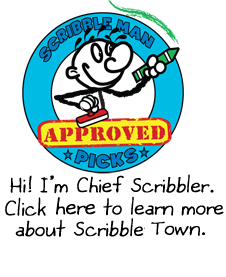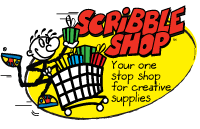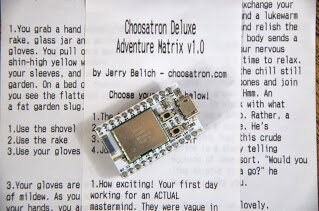Scribble Artist Interview with Jerry Belich!
Scribble Town (ST): Watch the above video and you’ll see why with an introduction like that we all think that Jerry Belich is a talented artist with a great sense of humor! Jerry, where are you and what are you up to these days?
Jerry Belich (JB): Spatially, I live and work in Northeast Minneapolis. I’m native to MN, but have been fortunate enough to travel quite a bit, including five weeks in London this past winter where the Choosatron was a big hit. I’m the senior mobile developer at Clockwork Active Media, I’m finishing up a movie swede of David Lynch’s Dune, and have been doing a few improv shows in the theatre community! I keep myself busy.
ST: Wow! On top of it all, I’m sure very busy trying to raise funds for Choosatron: Interactive Fiction Arcade Machine. I first stumbled upon
Choosatron on Kickstarter and your idea sounds great. Please let us know what the Choosatron is and what you are raising funds for. We’d like to help you!JB: Put simply, the Choosatron is small device that prints and plays Choose Your Own Adventure inspired stories. I was trying to think of something I wanted to build, and I thought back to the interactive books I read as a child, along with trips to the arcade. Since I built the first Choosatron, the excitement from both adults and kids has been incredibly motivating. I realized how fun it would be to use, not just as a toy, but a creative platform. It’s a lot of fun to play, but I’m excited to raise the funding for building the writing platform to go along with the device itself. In the broadest sense, I want to raise funding to build a bridge between the technological and creative, with storytelling at the center.
ST: When did you start creating interactive toys/games/play/amazing machines?! The thing is that you do so much! You are playful renaissance man. Was there somebody that encouraged you?
JB: I started creating my own interactive stories as a kid. I’d gather friends around, make up a beginning to a story, and give them each a turn to describe what they wanted their character to do in the world. It was my earliest form of roleplaying, though I never participated as a player, only as the game master. From there, making interactive stories and adventures on grid paper, to writing games in basic on an ancient computer. Game design and storytelling have always been lingering in my mind. More recently, it was a client working on the creative for a big installation project in Las Vegas that mailed me an Arduino after I mentioned my interest on a call. I’ve developed software for over a decade, but hadn’t done much tinkering with electronics. I’ve always worked to create more than I’ve been willing to advertise it, so many of my projects get completed, and then a spot on the shelf. It’s due to the encouragement of others that I’ve been more forthcoming. Not out of shyness, but honestly not expecting anyone to find any of it interesting.
ST: What inspired you to make Choosatron? How did the idea develop- conceptually and design wise? What made you choose text as the source of communication rather than images?
JB: Arcade machine and interactive stories. Specifically choice based, where narrative still has a stronghold over each step in the story. Sandbox games are endless fun, but for very different reasons, and I prefer to get lost in the story. Text is what I’m used to working with. I can’t draw to save my life, so there wasn’t much of a choice. That being the case, I did work on an interactive story using only pictures for the Little Printer by BERG at their second hack day in London. It was called “Ways to Die”. Once a day you’d get an image, starting with you washing up on the shore of an island. It would print a few QR codes, and the one to scanned first would determine the path for the next day. It might take a week, or even two, but one way or another you’d meet a terrible end on the island. I thought it was hilarious.
ST: When you develop software what is your creative process like? Would you call yourself a software developer? Your talents run all over the place! What are some other hobbies or interests you like?
JB: I tend to design as much in my head as possible, and then create the skeleton for the software I’m going to write. It’s all generally quite practical in that sense. What language, what platform, what are the constraints…you have to be pretty organized and have a process in order to work on a lot of projects at once. I’m already scatterbrained enough as it is. Software, and now hardware, is my career. I spend the rest of my time writing stories, putting together or taking part in improv shows, playing the theremin, and making videos or animation. I love hobbies and variety, so will just pick something up for a while and see if it comes in handy, like knitting or building puppets.
ST: Where do you find yourself feeling really inspired to create? In other words, is there a time of day that better suits these bubbles of creativity?
JB: I’m an extrovert, so being around people gives me energy. I also find the white noise of public places soothing, and have an easier time getting tasks done. I’ve carefully crafted my spaces at home to reduce how easy it is to get distract or too ‘comfortable’, but ultimately I can only get so much done at home. It used to be late at night was my most productive time, but I discovered that it was just being uninterrupted that helped. Actually, even just KNOWING I won’t get disturbed gets me into the right frame of mind quickly. The other element that helps is having access to the minds of whoever I know can help me with a creative problem since I work things out best by trying to explain them to someone. I really have these terribly opposed needs to get through my creative cycle which gets maddening sometimes.
ST: What is your process for getting your work out of your head? Do you sketch with pencil, paint, computer graphics, talk with certain friends for some good dialogue etc. ?
JB: Ah, well just was I was saying above! It’s talking and dialogue. I feel a strange disconnect between what I see in my head and what I’m able to jot down. I hate it because it makes capturing certain ideas much more difficult. I use a combination of a notepad that is always in my back pocket, a small pressurized pen in my front (I hate pens that stop working the moment you need them), and talking everything out with friends and professionals.
ST: What is your studio environment like? This is where the magic happens!
JB: Organized, at least usually. I get very anxious when I’m in big time crunches that don’t allow me to keep my work (and sometimes not work) spaces clear. I like large tables where I can spread out, and see everything at once, which is helpful for my absent mindedness. There are usually post-it notes with various types of todo lists, and a specific balance of comfort and utility. I want to want to be in my work space, but not want to take a nap.
ST: Since I haven’t yet played with the Choosatron, the idea led me to Brian Eno and Peter Schmidt’s Oblique Strategies game. Your game brings the player to the next level of the story all and Oblique Strategies helps the player break creative blocks by moving progressively forward, like a story does. What games do you like to play? Also, any game theorists you often looks towards for inspiration?
JB: Oblique Strategies is an interesting example. They created something for themselves in order to inspire themselves. In that fashion, the Choosatron is similar. I’ve created a tool that gives me a framework to write and design in a completely fresh way. The content of the cards themselves don’t do much for me though. I’m particularly fond of cooperative games, especially when players are not forced to cooperate with each other, or when one of you isn’t who they seem. I’m fascinated by the influences that cause people to band together and turn on each other. I love Betrayal at the House on the Hill and Red November quite a bit. Munchkin is a fantastic game. My new favorite is Epic Spell Wars of the Battle Wizards. I don’t know that I have specific game theorists that I look to, but I love exploring well known theories such as the Prisoner’s Dilemma within different mediums, and seeing how storytelling can affect the perception of the players. I’ll stop there as I could probably go on endlessly if you let me!
ST: Yes! You’ve given us, Scribblers, all whole lot to think about and plenty of inspiration to get started on making our own inventions, stories, and games.
JB: I think the scariest moments in life, especially creatively, are taking the first step to starting something new. You don’t know if you’re doing it right, or well (and in fact probably aren’t), but you have to push through that in order to find the really great work you are capable of. You need to make the mistakes, gain the confidence, and practice. Trust yourself, and you’ll be rewarded for it!
ST: Thanks Jerry! That’s perfect advice! Just make your idea come true and let’s see where that shall take us. For more information on Jerry Belich and his artwork, please visit his Choosatron website and Monkey with a Mustache Entertainment.

Logo of Jerry Belich’s ‘Monkey with a Mustache Entertainment’ Check out more of Jerry’s projects at http://monkeytheater.com and http://choosatron.com







